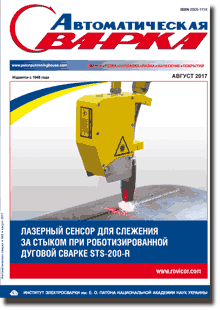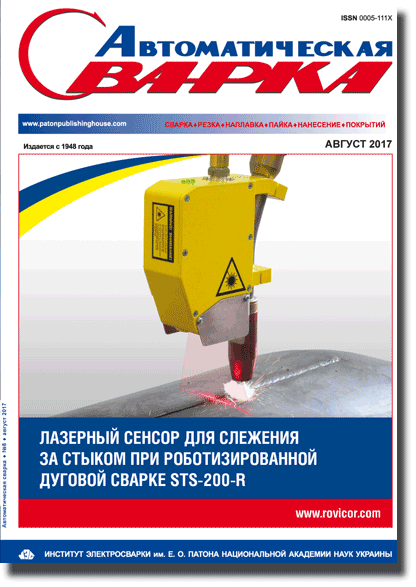| 2017 №08 (04) |
DOI of Article 10.15407/as2017.08.05 |
2017 №08 (06) |

Avtomaticheskaya Svarka (Automatic Welding), #8, 2017, pp. 37-46
Development of technology and equipment for reduction of residual stresses and straightening in welded structures applying electrodynamic treatment
L.M. Lobanov and N.A. Pashchin
E.O. Paton Electric Welding Institute, NASU 11 Kazimir Malevich Str., 03680, Kiev, Ukraine. E-mail: office@paton.kiev.ua
Abstract
A new technological process of postweld treatment of welded joints is presented, namely the electrodynamic treatment by pulses of high-density electric current. The carried out complex of experimental investigations on specimens of aluminium alloy AMg6 at different parameters of electric current pulses and inductance of power source showed that electrodynamic treatment influences the structure of treated metal and allows a significant reduction in residual stresses in welded joints, increasing their resistance to fatigue and brittle fracture, and also eliminating buckling deformations of thin-walled structural elements. The developed technologies and equipment provided the possibility of performing electrodynamic treatment of welded joints of ship-building structures and repair welds of intermediate casing of aircraft engine, which facilitated their increased operational reliability and service life. 8 Ref., 18 Figures.
Keywords: electrodynamic treatment, aluminium alloy, welded joint, residual stresses, current pulse, mathematical modeling, current density, plastic deformation
Received: 03.04.17
Published: 01.08.17
References
- Baranov, Yu.V., Troitsky, O.A., Avramov, Yu.S. (2001) Physical principles of electropulse and electroplastic treatment and new materials. Moscow: MGIU.
- Lobanov, L.M., Kondratenko, I.P., Zhiltsov, A.V. et al. (2016) Electrophysical unsteady processes in the system to reduce residual stresses welds. Tekhnichna Elektrodynamika, 6, 10–19. https://doi.org/10.15407/techned2016.06.010
- Sidorenko, Yu.M., Shlenskii, P.S. (2013) On the assessment of stress-strain state of the load-bearing structural elements in the tubular explosion chamber. Strength of Materials, 45(2), 210–220. https://doi.org/10.1007/s11223-013-9450-5
- Kishkina, S.M., Bratashev, V.L., Guk, N.V. (1988) Fracture of aluminium alloys: Atlas of fractograms. Moscow: VIAM.
- Yakovleva, T.Yu. (2003) Local plastic deformation and fatigue of metals. Kiev: Naukova Dumka.
- Darovsky, Yu.F., Markashova, L.I., Abramov, N.P. (1985) Method of preparation for electron microscopic examinations. Svarka, 12, 60.
- Lobanov, L.M., Pivtorak, V.A., Savitsky, V.V. et al. (2006) Procedure for determination of residual stresses in welded joints and structural elements using electron speckle-interferometry. The Paton Welding J., 1, 24–29.
- Masubuchi, K. (1980) Analysis of welded structures. Pergamon Press.
The cost of subscription/purchase order journals or individual articles
| Journal/Currency | Annual Set | 1 issue printed |
1 issue |
one article |
| TPWJ/USD | 384 $ | 32 $ | 26 $ | 13 $ |
| TPWJ/EUR | 348 € | 29 € | 24 € | 12 € |
| TPWJ/UAH | 7200 UAH | 600 UAH | 600 UAH | 280 UAH |
| AS/UAH | 1800 UAH | 300 UAH | 300 UAH | 150 UAH |
| AS/USD | 192 $ | 32 $ | 26 $ | 13 $ |
| AS/EUR | 180 € | 30 € | 25 € | 12 € |
| SEM/UAH | 1200 UAH | 300 UAH | 300 UAH | 150 UAH |
| SEM/USD | 128 $ | 32 $ | 26 $ | 13 $ |
| SEM/EUR | 120 € | 30 € | 25 € | 12 € |
| TDNK/UAH | 1200 UAH | 300 UAH | 300 UAH | 150 UAH |
| TDNK/USD | 128 $ | 32 $ | 26 $ | 13 $ |
| TDNK/EUR | 120 € | 30 € | 25 € | 15 € |
AS = «Automatic Welding» - 6 issues per year;
TPWJ = «PATON WELDING JOURNAL» - 12 issues per year;
SEM = «Electrometallurgy Today» - 4 issues per year;
TDNK = «Technical Diagnostics and Non-Destructive Testing» - 4 issues per year.





